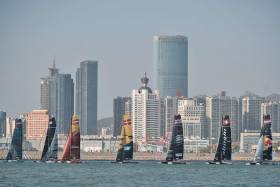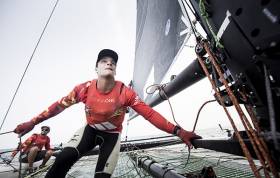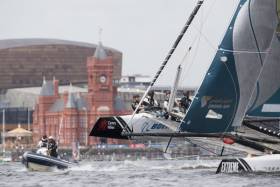Displaying items by tag: Extreme Sailing Series
#ExtremeSailing - ‘Marine Formula 1’ is how the high-performance vessels of the Extreme Sailing Series are being described in Qingdao, China, where the fleet has amassed this weekend for the Mazarin Cup.
It marks the second stage of the 2017 edition of the series that since 2007 has brought together round-the-world yachtsman, America’s Cup veterans, Olympic medallists, world record holders and other elite sailors to race speedy and nimble foiling GC32 catamarans within a stadium environment.
Among them is Howth Yacht Club’s own Shane Diviney, who crews skipper/helm Chris Steele’s NZ Extreme team as headsail trimmer.
No stranger to the series, Diviney spoke to Afloat.ie last September about his experience with Steele’s previous team CHINA One and the wildcard Gazprom Team Russia.
“The Extreme Sailing Series is the most challenging racing for the crews I have done,” he said.
You can follow Diviney and the rest of the fleet in action with live streams on the official YouTube channel.
Howth Yacht Club's Shane Diviney is Extreme Sailing on Gazprom Team Russia
Afloat.ie caught up again with Howth Yacht Club's Shane Diviney, the only Irish sailor racing on the Extreme Sailing Series in Russia where the pro match-racer is onboard Gazprom Team Russia instead of his regular China One team.
You are here in St Petersburg racing with Gazprom Team Russia. How has that been?
I was able to join Gazprom Team Russia for the Extreme Sailing Series for the St. Petersburg Act because my usual team, China One, are not doing this event. This is Gazprom Team Russia’s debut event on the Extreme Sailing Series for 2016 and we are representing the St. Petersburg Yacht Club as the local entry for this event. I think the team has gelled really well considering we have never sailed together as a team. We have shown that we can mix it up with the more established teams on this tour. We were happy with our speed and have identified the areas where we need to improve.
You have done a few ESS events now. What is the best thing about the Series in your opinion and what is so appealing about the circuit?
The Extreme Sailing Series is the most challenging racing for the crews I have done. The race course is always so short and usually confided by numerous physical boundaries, although we do get the chance to do some open water racing at some events, which is also great. With the GC32s travelling at such high speeds you are never going in a straight line for more than a couple of minutes. This puts a big emphasis on your manoeuvres and often the teams that have the slickest and least amount of manoeuvres will be in the top 3. The highly challenging racing makes this circuit attractive to both the sailors and the spectators.
What can you tell us about the competition? Which are the strongest teams and why?
Oman Air and Alinghi have proved to be the boats to beat all season. The top teams always try to keep the racing uncomplicated and reduce the potential for error. There are always big gains to be made around the race course if you can manage to get your boat in clear air and reduce the amount of manoeuvres. This is what we have strived to achieve this week on Gazprom Team Russia here this week.
What is for you next after the St Petersburg Act?
My next regatta will be in Sotogrande (Spain) with Team Armin Strom sailing in the GC32 Racing Tour. We are currently sitting 3rd overall in that series so we will be hoping to consolidate our podium position in the final two events of the season. After this, I will hopefully be going to Lisbon for the Act 7 of the Extreme Sailing Series.
Shane Diviney from Howth Yacht Club represents Irish sailing interests at the Extreme Sailing Series this weekend in Cardiff. The unique global professional racing circuit visits eight countries in ten months where seven international crews compete including the Dublin born pro-sailor Diviney.
Diviney (25) has clocked up a lof of professional experience in many sailing circuits (see CV below) but this is his first inclusion in the Extreme Sailing Series where he races with the Chinese flagged team.
- Shane's role with China One for the Extreme Sailing Series:
"I am part of the sailing team with China One. I was trimming in Act 1 and 2 in Muscat and Qindago. In Cardiff I am filling in on the bow for Chris Steele who is injured. Doing bow on the GC32 involves trimming the board rake on the foils which controls our flight."
- What it means to Shane to be part of the team and the Series:
"It is exciting to be involved in a Series that I have followed for many years. 2016 was a great year for China One to join the ESS with the move to the foiling GC32 boats. These boats are at the forefront high performance racing at the moment and I feel very lucky to be involved in this new style of sailing."

Shane competing in China One (left) yesterday in Cardiff. Photo: Mark Lloyd
- Why is the Extreme Sailing Series different to other sailing events Shane has been involved with:
"The racing in the Extreme Sailing Series is very much geared towards spectator friendly sailing, with racing always taking place very close to shore and very little sea room in which the race course can be laid. In some venues such as Cardiff it is not possible for the race committee to set a traditional windward/ leeward race course given the usual wind direction. Therefore they have to get creative with the race course. I find it refreshing to do these more unusual course formats when we are used doing standard windward/ leeward courses in most other racing. Racing close to land also means that the breeze is usually very gusty and shifty which can make things interesting when you have 8 foiling boats meters apart doing 30+ knots."
Shane's CV:
- Born in Dublin on 20.05.91
- Ireland and New Zealand Match Racing champion
- 1st Class 0 2015 Sydney to Hobart Yacht Race
- 3rd 2015 GC32 Riva Cup - Lake Garda
- 1st 2015 Warren Jones Youth International
- 2nd Youth European Match Racing Champs
Only days after Oman's record breaking run in Wicklow brought a new Round Ireland Irish speed sailing time another Oman multihull crew othe other side of the Irish Sea turned the focus in Cardiff from tough test to tough team after launching their Welsh campaign with a string of successes to end the opening day at the top of the Extreme Sailing Series leaderboard.
A fresh but shifting breeze that held its strength throughout the eight races made for some eye catching action as the GC32s flew across the water at full tilt on their foils.
They were conditions ideally suited to Morgan Larson’s powerful crew on Oman Air, who are well-known to excel in big breeze.
The result was a stunning victory in the opening race followed by four further outright wins and an additional podium place bringing their score to 85 points, two points ahead of second placed Red Bull with Alinghi in third trailing by six points.
Consistent breeze has been forecast for the rest of the week and that came as good news for Pete Greenhalgh and other crewmembers Nasser Al Mashari, Ed Smyth and James Wierzbowski.
“We would love it if it is the same again for the rest of the week because we really like this venue,” said Greenhalgh, who has gathered family and friends from his home in Hampshire to lend Oman Air some special support.
“It’s renowned for nice breeze, it is a very boat handling oriented course and very changeable in terms of direction and strength. It’s exciting and we are just trying to sail to our full potential. Today we got into our stride and sailed round the course pretty tidily.
“These GC32 boats are very physical especially in these winds so we are always out of breath. Every time we tack and gybe, we have to drop and hoist these great big boards and that is really hard work because they have all the weight of the boat and crew on them.
“They require a serious bit of handling so on a small course like this, timing is everything, which is fine if you have the time but in these winds, you rarely do. But it’s brilliant.”
The close contest between the top three boats makes the remaining three days a thrilling prospect, added Nasser, Oman Air’s bowman.
“Red Bull and Alinghi are both very strong competitors but we have learned to concentrate on our own performances and not look out for anyone else so we will focus on our starts, boat-handling and teamwork and hopefully the results will come,” he said.
“Today was tough but we sailed well. Our teamwork was great. So far so good.”
Oman Air, who also lead the 2016 overall leaderboard by two points, continue racing on Friday June 24 through to Sunday June 26. Fans can watch the racing live on the official YouTube channel on 25-26 June, 1530-1700 BST daily. In the UK, they can also watch it live on BT Sport on the final day.































































